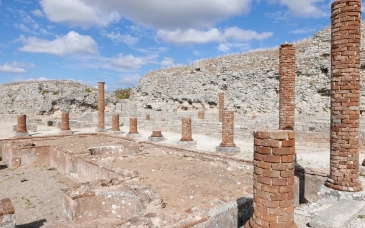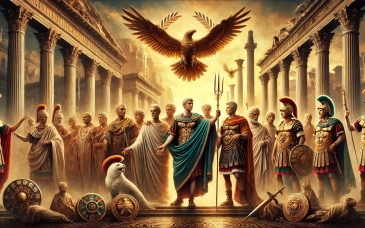The story of early Christianity in Roman Portugal is a fascinating tale of religious transformation, cultural interaction, and resilience. During the Roman period, the region known today as Portugal was primarily encompassed within the province of Lusitania, which extended into parts of modern-day western Spain. The spread of Christianity in Lusitania reflects the broader movement of early Christianity across the Roman Empire, marked by waves of acceptance, persecution, and eventual triumph.
1. Roman Lusitania Before Christianity
Before the arrival of Christianity, Roman Lusitania was characterized by a rich tapestry of religious beliefs that included the worship of indigenous deities alongside the Roman pantheon. The religious practices of Lusitanian tribes were deeply rooted in nature worship, venerating gods such as Endovelicus, associated with health and the underworld, and Ataegina, a goddess linked to rebirth and fertility.
Under Roman rule, these native beliefs were either syncretized with Roman gods or practiced alongside them. Temples dedicated to Jupiter, Mars, and Diana could be found in urban centers, reflecting the spiritual and civic life that pervaded the province. The Romans also brought their festivals, rituals, and public sacrifices, which reinforced their cultural and political influence.
2. The Introduction of Christianity
The spread of Christianity to Lusitania likely began in the 1st century CE as a result of increased trade, communication, and travel throughout the Roman Empire. Missionaries and merchants, who were already active in major Roman trade routes, played a crucial role in introducing the new faith to the western provinces.
Christianity's arrival in Lusitania coincided with a time of political stability under the Pax Romana, which facilitated the movement of people and ideas across vast distances. Key urban centers like Emerita Augusta (modern Mérida) and Olisipo (modern Lisbon) were vital hubs of commerce and culture, making them likely points for the initial spread of Christian teachings.
3. Challenges and Persecutions
Despite its initial spread, the adoption of Christianity in Lusitania was fraught with challenges. The Roman Empire, particularly during the early centuries, regarded Christianity with suspicion. Unlike traditional Roman religion, Christianity rejected the worship of the emperor and the pantheon of Roman gods, which was seen as subversive to the unity and authority of the state.
Persecutions under emperors like Nero, Domitian, and Diocletian affected Christians throughout the empire, including Lusitania. Accounts from early Christian martyrs, though scarce, suggest that believers faced harsh punishments for their refusal to participate in state-sanctioned religious practices. While detailed records specific to Lusitania are limited, it is reasonable to infer that these persecutions touched the Christian communities emerging in the region, as they did elsewhere in the Roman world.
4. Communities and Worship Practices
Early Christian communities in Lusitania were small and often centered around urban centers and rural villas where believers could meet in secret. House churches became the norm, with Christian worship held in private homes to avoid attracting unwanted attention. These gatherings included reading scripture, prayer, and the Eucharist, emphasizing community and equality, which stood in stark contrast to the hierarchical nature of Roman religious rituals.
The first Christian converts were likely from various social backgrounds, including merchants, freedmen, and even Roman officials who found the message of Christianity appealing due to its spiritual inclusivity and promise of salvation.
5. The Role of Missionaries and Martyrs
The growth of Christianity in Lusitania was significantly influenced by the efforts of missionaries and early bishops who traveled to spread the faith. Though their names may not all be preserved in the historical record, there are figures like Saint Verissimus, his sisters Maxima and Julia, and Saint Marcellus of Tangier, whose stories contribute to the narrative of Christianity’s roots in the Iberian Peninsula.
Martyrdom played a powerful role in strengthening Christian resolve and encouraging the spread of the faith. Accounts of martyrdoms, when recorded or passed down orally, would galvanize believers and attract new converts. The sacrifices of martyrs were seen as testament to the truth and power of their beliefs, promoting a sense of solidarity and purpose among early Christians.
6. The Edict of Milan and Legalization of Christianity
A significant turning point for Christianity came in 313 CE with the Edict of Milan, issued by Emperor Constantine and co-emperor Licinius. This decree granted religious tolerance throughout the Roman Empire and allowed Christianity to be practiced openly without fear of persecution. In the years that followed, Christianity rapidly gained followers, and its integration into Roman society began in earnest.
In Lusitania, this shift led to the public emergence of previously hidden Christian communities. Churches and basilicas were constructed, often using or repurposing older pagan temples as sites for Christian worship. This practice of converting temples helped assimilate Christian worship into familiar civic spaces, aiding in the religion’s broader acceptance.
7. Development of Church Hierarchy
As Christianity grew, so did its organizational structure. Bishops and other church officials were appointed to oversee the spiritual and administrative needs of their communities. In Lusitania, key cities like Emerita Augusta became important centers for ecclesiastical leadership. The Council of Elvira (circa 305–306 CE), though centered in neighboring Hispania Baetica, would have had repercussions in Lusitania, shaping the doctrinal and moral guidelines for Christians in the region.
8. Integration with Local Customs
One of the most interesting aspects of early Christianity in Lusitania was how it adapted to and integrated with local customs and beliefs. Many pre-Christian practices did not disappear entirely but were instead reinterpreted through a Christian lens. For example, traditional festivals and rituals that celebrated natural cycles and deities were often Christianized, becoming associated with saints or significant Christian feasts.
Saint worship and pilgrimage emerged as prominent practices in Lusitania, blending with the older veneration of local deities. Sites associated with martyrs or miraculous events became places of pilgrimage, drawing believers from across the region and reinforcing the spread of Christianity.
9. Influence on Art and Architecture
With the legalization of Christianity came a new era of religious art and architecture in Lusitania. Churches were built to accommodate growing congregations, featuring designs that adapted Roman basilica-style layouts to serve Christian liturgical purposes. Mosaics, frescoes, and inscriptions began to reflect Christian themes, incorporating symbols like the Chi-Rho, the fish, and the cross.
Catacombs and burial practices also changed as Christians began to favor burial over cremation, in accordance with their beliefs in bodily resurrection. Archaeological findings in places such as Mértola reveal tombs and artifacts that underscore the growing Christian identity of the region during the later stages of the Roman Empire.
10. The Transition to the Post-Roman Period
As the Western Roman Empire weakened and eventually fell in the 5th century CE, Lusitania and the wider Iberian Peninsula faced invasions from various Germanic tribes, such as the Suebi and Visigoths. These groups, many of whom were initially Arian Christians, contributed to the complex religious landscape of post-Roman Lusitania. However, over time, Nicene Christianity became dominant, especially as the Visigoths adopted it in place of Arianism.
This period marked the transition from Roman rule to the early medieval era, during which the foundations laid by Roman Christianity continued to shape religious practice and belief. The legacy of these early centuries of Christian growth would endure, influencing the region’s religious character through the Middle Ages and beyond.
The arrival of early Christianity in Roman Portugal was a multifaceted process marked by gradual introduction, resilience through persecution, and eventual integration into the fabric of society. From secret house gatherings to the construction of grand basilicas, the Christian faith transformed Lusitania, weaving itself into its culture, art, and collective consciousness. This religious transformation laid the groundwork for centuries of Christian influence in Portugal, impacting not just religious practices but also shaping social and political structures that would resonate well into the medieval period. The story of early Christianity in Lusitania is thus a testament to the power of belief, community, and adaptation in the face of both challenge and change.

